All products featured are independently chosen by us. However, SoundGuys may receive a commission on orders placed through its retail links. See our ethics statement.
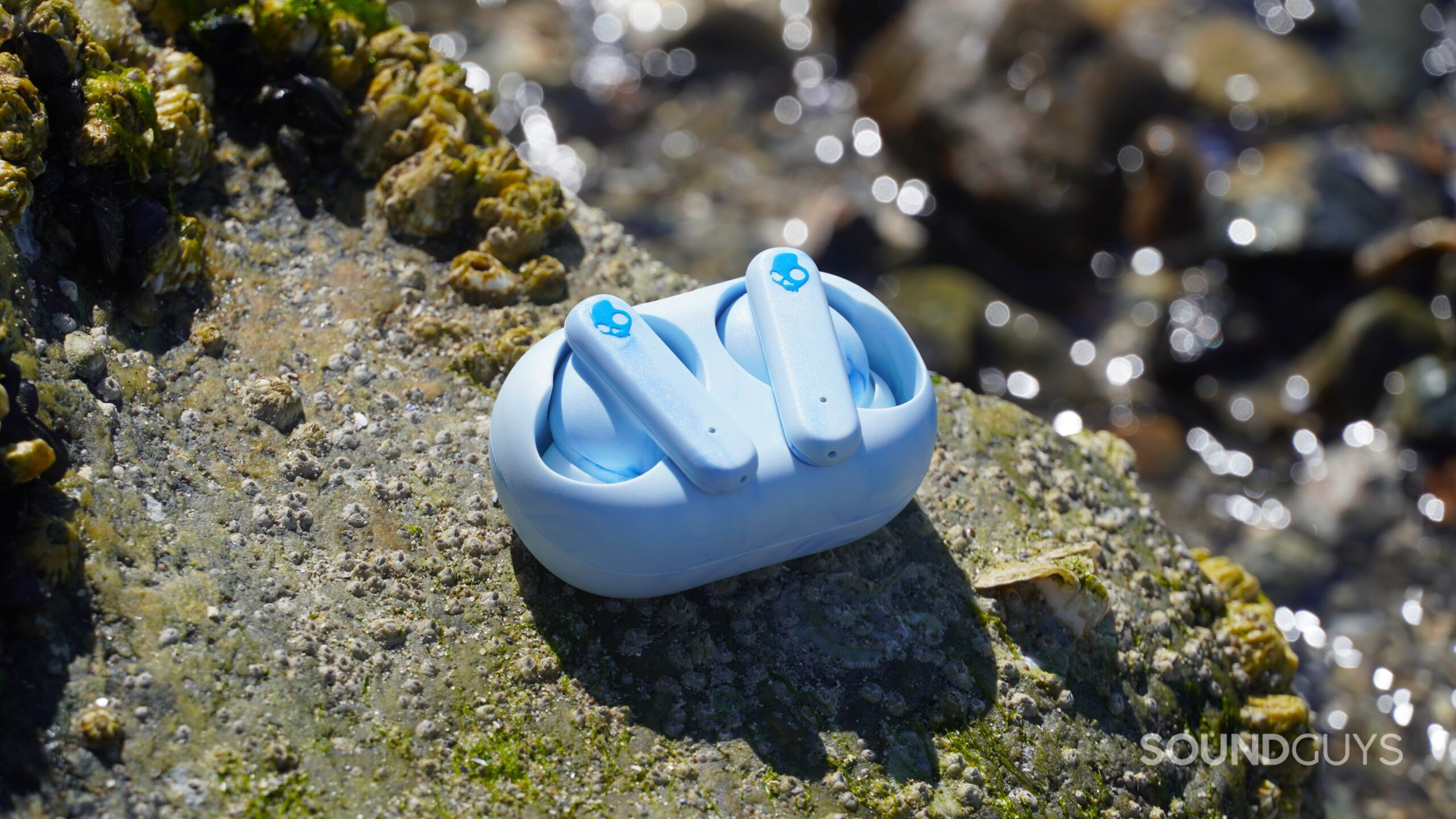
Skullcandy EcoBuds review
June 18, 2024
Skullcandy EcoBuds True Wireless Earbuds
It’s no secret that e-waste is a huge contributor to the pollution affecting the planet. Wireless earbuds, in particular, have an average lifecycle of only two to three years, with many people frequently discarding their old ones in favor of the latest and greatest. Skullcandy is one company aiming to reduce its environmental impact with the new EcoBuds, which they claim has half the carbon footprint of comparable products. But can they deliver enough performance to win over those prioritizing sound quality and features over the environment? Read on to find out.
Editor’s note: this is the first version of the article. Updates will follow as the market changes.
The Skullcandy EcoBuds are for eco-conscious individuals willing to sacrifice features such as ANC and a secure carrying case with a battery in favor of minimizing the impact on the environment. They are made of recycled materials and passable sound quality, but some alternatives offer better features for the same affordable price tag.
What’s it like to use the Skullcandy EcoBuds?
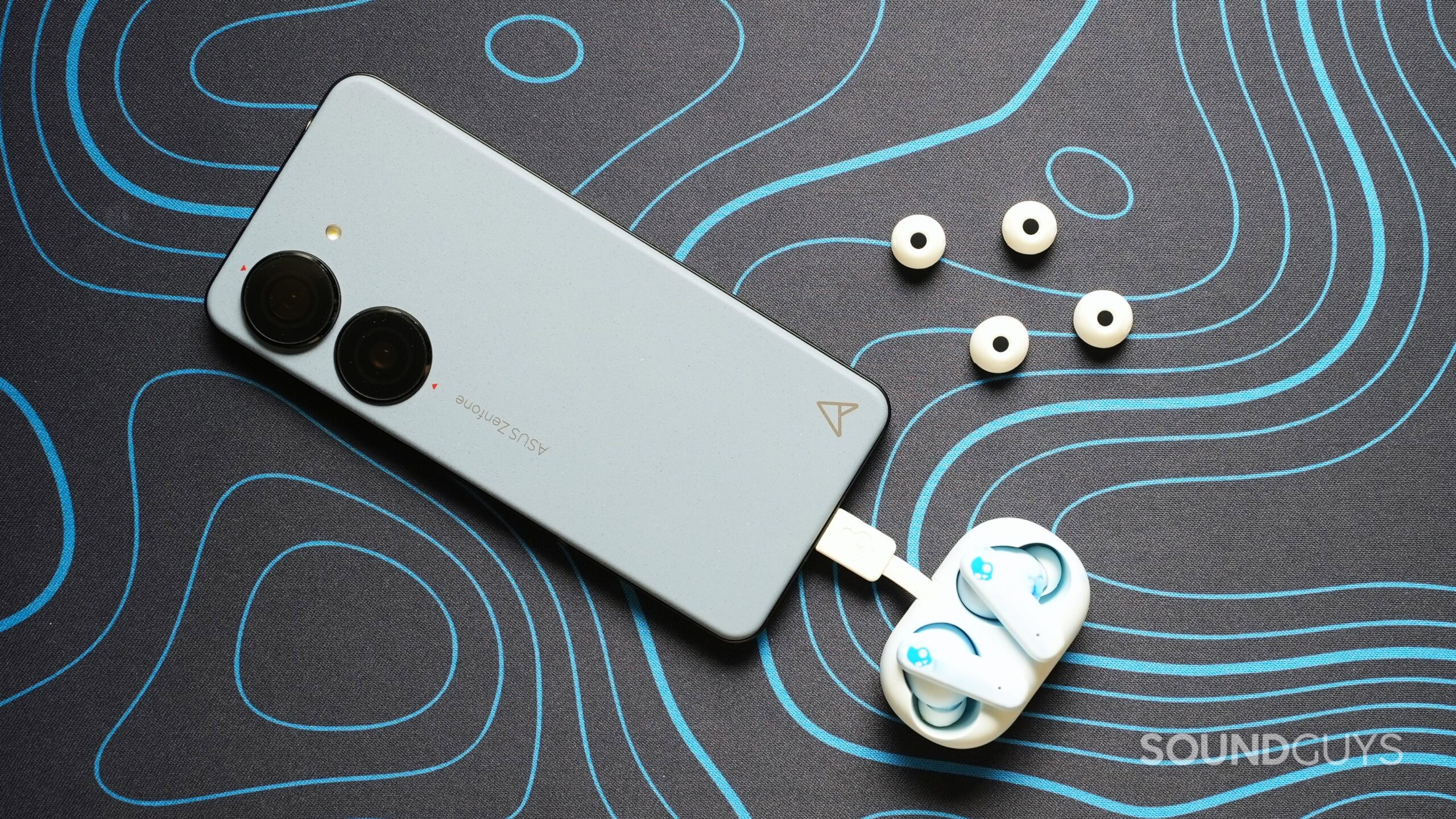
The Skullcandy EcoBuds are made with 65% recycled plastics and only come in the color Glacier, a light-blue-and-white marbled pattern that reminds me of the melting ice caps. But the most unique thing about them has to be the storage case — if you want to call it that. Skullcandy refers to it as a charging dock, which is probably more accurate because it doesn’t have a lid to keep the earbuds enclosed. That means the earbuds are left exposed, and while the magnets are strong enough to keep them from falling out with the shake test, they will go flying if you drop them to the floor.
The exposed charging dock, with its short cable, can be a pain to use.
The charging dock also lacks a battery. Instead, it has a short USB-C cable that tucks away underneath, which you can plug into your phone or laptop to charge the earbuds. The cable is only 1.5 inches long, which might mean it dangles from specific devices and fights for space if you have crowded ports. Overall, I found the design impractical, but others may be willing to cut these conveniences.
The earbuds themselves come with three sizes of ear tips, and I got a reasonably good seal with the medium ones. The earbuds are IPX4-rated, meaning they are resistant to sweat and water. Skullcandy implemented various functions using intuitive single-, double-, triple-, and even quadruple-tap gestures, which the included instruction manual illustrates. While the touch controls are very responsive, the placement of the touch-sensitive Skullcandy logo directly over the ear can cause some uncomfortable pressure as every tap can push the earbuds further into your ear canal if you aren’t gentle. I would have much preferred it if they had implemented squeeze controls along the stem design, similar to the Nothing Ear (a), to avoid this.
| Left Earbud | Right Earbud | |
|---|---|---|
Press for 1.5s | Left Earbud Power On | Right Earbud Power On |
Press for 4s | Left Earbud Power Off | Right Earbud Power Off |
Single tap | Left Earbud Play / Pause / Answer | Right Earbud Play / Pause / Answer |
Hold for 1s | Left Earbud Volume Down | Right Earbud Volume Up |
Double tap | Left Earbud Track Forward | Right Earbud Track Forward |
Triple tap | Left Earbud Track Backward | Right Earbud Track Backward |
Quadruple tap | Left Earbud Activate Assistant | Right Earbud EQ Mode Change |
How do the Skullcandy EcoBuds connect?
Connectivity is pretty basic; the EcoBuds use Bluetooth 5.2, which isn’t the latest, and they only work with the AAC and SBC codecs. I didn’t experience any noticeable latency during my listening. There is no Bluetooth multipoint.
- Press and hold the Skullcandy button on both earbuds simultaneously for 3 seconds.
- Continue holding the buttons until the LED lights on both earbuds start flashing red and white.
- The earbuds are now in pairing mode and ready to be connected to your device.
To clear paired devices:
- Press and hold the Skullcandy button on both earbuds simultaneously for 6 seconds.
- The LED lights will flash, indicating that the paired devices have been cleared from the earbuds’ memory.
How long does the Skullcandy EcoBuds battery last?
In our standardized testing, the EcoBuds lasted 6 hours and 46 minutes, less than Skullcandy’s advertised 8-hour claim, though pretty good for true wireless earbuds. Given the lack of a battery, the charging dock does not provide additional battery life.
Yes, when plugged in, the charging dock does support rapid charging, with ten minutes averaging around 2 hours of playback.
How well do the Skullcandy EcoBuds block out noise?
Loading chart ...
The amount of environmental noise passively isolated while wearing the EcoBuds will primarily depend on the fit you achieve with the three sizes of ear tips included. These earbuds struggle to block out low-end frequencies below 500 Hz. Still, they do a good job of eliminating high-pitch noises, achieving a 75% reduction in perceived loudness.
There is no active noise canceling, however, which means these earbuds aren’t great for listening in loud environments. Overall, I found the isolation adequate for tuning into my music at home, but if you are walking down a busy street or riding the bus, you will hear the rumble of traffic and engines.
How do the Skullcandy EcoBuds sound?
The Skullcandy EcoBuds sound surprisingly good, with a natural sound that most people will enjoy.
Multi-Dimensional Audio Quality Scores (MDAQS)
The chart below shows how the sound of the Skullcandy EcoBuds was assessed by the Multi-Dimensional Audio Quality Score (MDAQS) algorithm from HEAD acoustics.
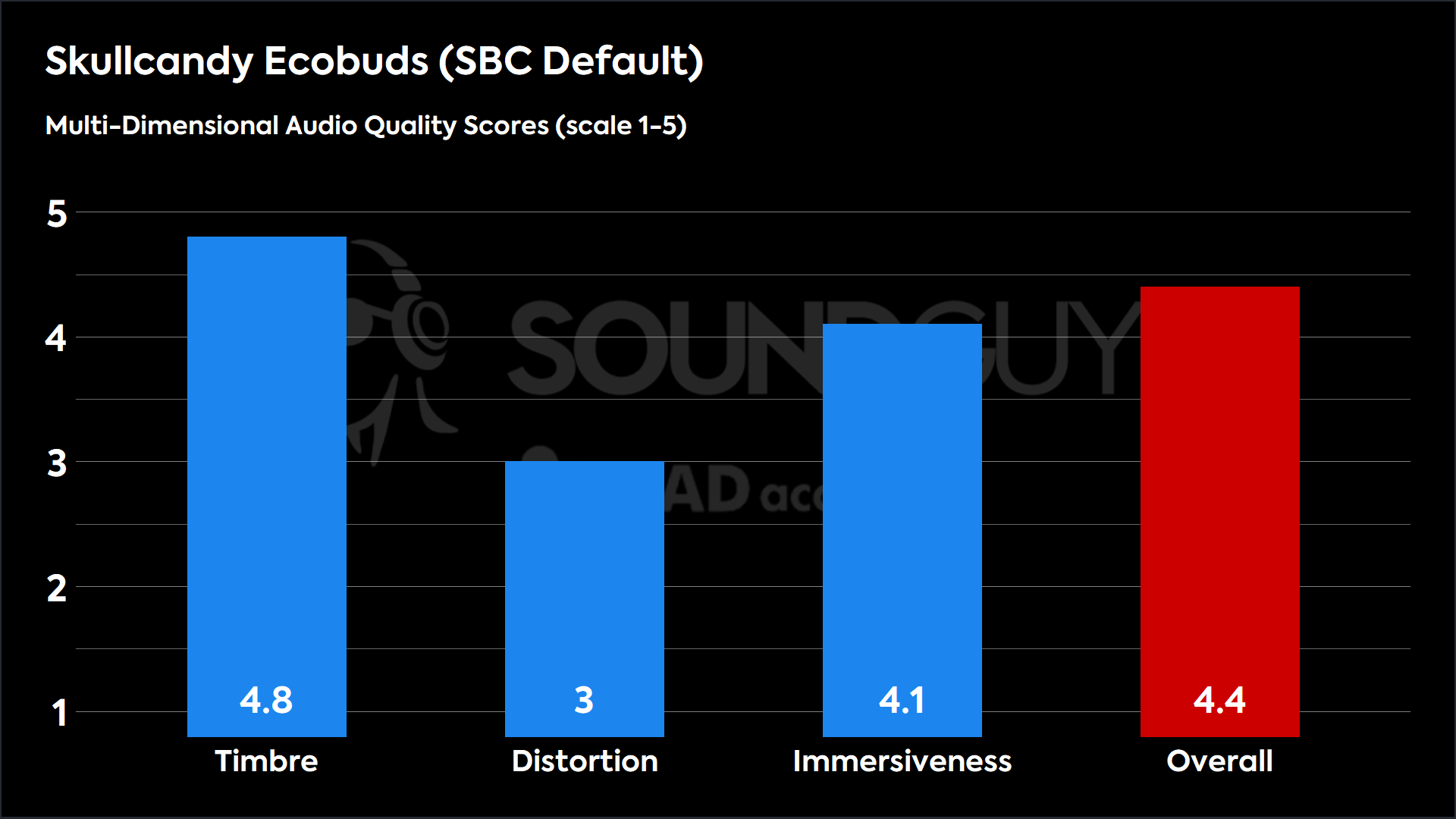
The Skullcandy EcoBuds score an impressive 4.8 in Timbre, meaning most people will enjoy the default sound out of the box with these earbuds. A score of 3 in Distortion is just okay, bringing the overall score down to 4.4, which is still nothing to sniff at. According to this simulated panel of listeners, most people will be fine with the sound quality here.
- Timbre (MOS-T) represents how faithfully the headphones reproduce the frequency spectrum and temporal resolution (timing information).
- Distortion (MOS-D) represents non-linearities and added noise: higher scores mean cleaner reproduction.
- Immersiveness (MOS-I) represents perceived source width and positioning, which is how well virtual sound sources are defined in three-dimensional space.
See here for an explanation of MDAQS, how it works, and how it was developed.
Reviewer’s notes

There’s a tendency to think that cheap wireless earbuds can’t sound as good as the expensive flagship models, even though there is no such correlation. I suspect that bias might also extend to earbuds made from recycled materials. I’m happy to report that neither is the case here; the EcoBuds sound pretty good.
While listening to the latest album from L’Impératrice, Pulsar, the instruments in many of the songs, such as the band’s funky guitar riffs, synth leads, and disco-inspired basslines, are all complemented by a neutral-leaning midrange. However, occasionally, I did notice spikes in the highs that were louder than I prefer, with some of the electronic elements and distorted vocals coming across as slightly harsh.
Listening to The Weeknd’s “Blinding Lights” on the EcoBuds, I noticed that the earbuds’ spatial depth was somewhat limited. While the track’s bassline and drum beats were well-reproduced, the perceived distance between the various elements of the mix felt slightly compressed. Abel Tesfaye’s vocals occupy a plane similar to the instrumentation rather than standing out in front of the mix. But that’s unlikely to be a dealbreaker for most listeners.
Objective Measurements
Loading chart ...
As you can see in the chart above, the Skullcandy EcoBuds’ default frequency response loosely follows our headphone preference curve with more emphasis in the lows by 2-4dB until 300Hz. This is a common occurrence in earbuds that don’t have ANC since the bass emphasis can help drown out common sources of noise.
The Skullcandy EcoBuds’ frequency response is strikingly similar to the Skullcandy Dime 3. Vocals are clear, and most instruments have a relatively even balance. However, a peak in the highs between 5-9kHz can make things like cymbals or hi-hats sound shrill, which can get tiring after a couple of hours of listening.
If you don’t like the default sound of the earbuds, you can try two other built-in EQ presets. One is a Bass Boost mode, which, as you can imagine, gives you some more oomph in the low-end. The other is Podcast Mode, which cuts a lot of low frequencies to amplify mid-range voice frequencies.
Can you use the Skullcandy EcoBuds for phone calls?
The Skullcandy EcoBuds’ onboard microphones capture your voice in ideal, quiet conditions. However, that’s not the case when you use them in a noisy office or busy street. The more environmental noise or wind around you, the harder it will be for the person on the other end of the line to understand what you are saying.
Skullcandy EcoBuds microphone demo (Ideal conditions):
How does the microphone sound to you?
Skullcandy EcoBuds microphone demo (Office conditions):
Skullcandy EcoBuds microphone demo (Street conditions):
Skullcandy EcoBuds microphone demo (Windy conditions):
Skullcandy EcoBuds microphone demo (Reverberant space):
As you can hear in the demos above, the mics pick up a lot of background noise in real-world scenarios, making communication extremely difficult.
Should you buy the Skullcandy EcoBuds?
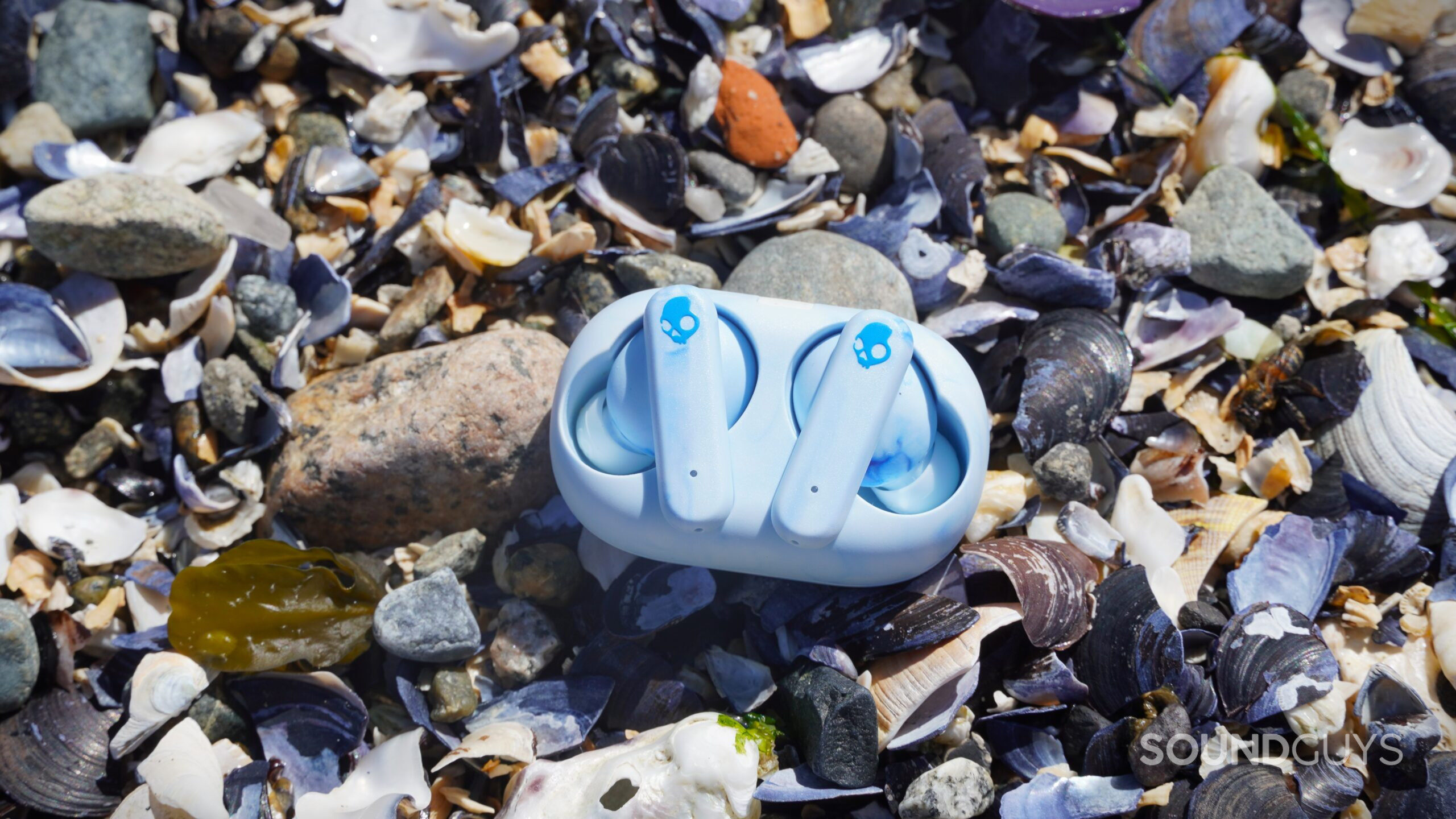
If you want affordable wireless earbuds that won’t end up in a landfill in three years, the Skullcandy EcoBuds are a decent choice. With an overall inoffensive sound signature and effective passive isolation, most users will find them suitable for casual listening.
The Skullcandy EcoBuds are a commendable attempt at creating eco-friendly wireless earbuds without compromising too much on sound quality.
However, the Achilles’ heel for many will be the impractical charging dock design. While compact, without a lid, portability becomes a concern, with the earbuds getting easily lost when tossed into a bag or dropped. And without a built-in battery, they will only survive the day by leeching off your phone’s power by the thread of a relatively short cable. Additionally, the microphone performance in noisy environments is subpar, making them less suitable for calls on the go.
If you prioritize environmental sustainability and affordability and can settle for decent sound quality, the Skullcandy EcoBuds are worth considering. However, if you require a more feature-rich experience or a more practical charging solution, other alternatives in the sub-$50 market will better suit your needs.

What should you get instead of the Skullcandy EcoBuds?
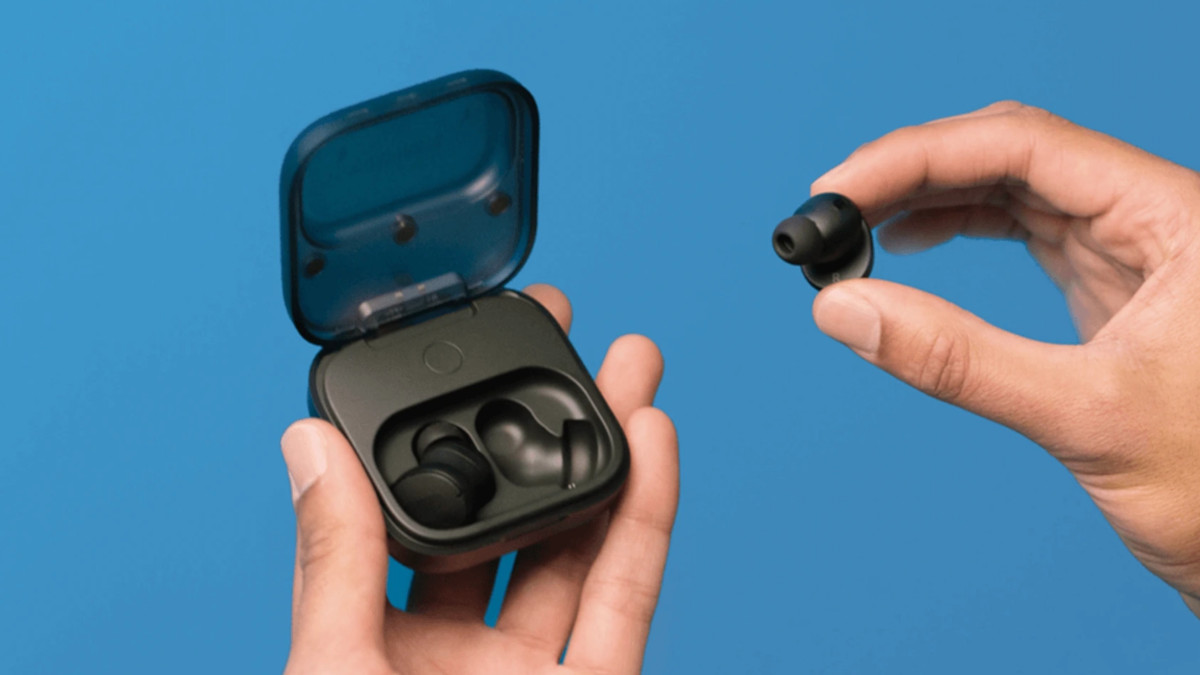
There aren’t many options for sustainable wireless earbuds, but one alternative is the Fairphone Fairbuds. They could theoretically last you a lifetime as they are fully repairable with a replaceable battery in the charging case and both buds. They are a bit more expensive but have features such as ANC, a dedicated mobile app with an equalizer, an IP54 rating, and a more secure charging case. However, while our review is still forthcoming, our initial impressions of the sound quality aren’t exactly stellar.
If you want to stick with Skullcandy, the Dime 3 offers impressive sound quality and good bang for the buck for only $29.99 at Amazon. We also recommend the JLab JBuds Mini for those with smaller ears. They have much better isolation, and a good companion app for $39.99 at Amazon. If you can spend a bit more, the Edifier TWS1 Pro 2 has excellent noise canceling and is a great choice for gym rats who want something cheap ($49.99 at Amazon), durable, and portable to toss in their gym bag.
Frequently asked questions
No, there is no companion app.
Skullcandy offers a range of earbuds with varying features and performance. The EcoBuds, in particular, deliver good sound quality but have limited features compared to other options in the market.
The Skullcandy EcoBuds have an IPX4 rating, which means they are resistant to sweat and water splashes but not fully waterproof.
Yes, the Skullcandy EcoBuds have built-in microphones for making calls, but their performance in noisy environments is subpar.
The Skullcandy EcoBuds are compatible with iPhone and Android devices via Bluetooth. However, they only support SBC and AAC codecs, and Android users do not have aptX support.
The Skullcandy EcoBuds do not have active noise cancelation (ANC). They rely on passive isolation, which reasonably blocks high-frequency noises but struggles with low-end frequencies.
Thank you for being part of our community. Read our Comment Policy before posting.